A Special Day All Around at Perissos Vineyards: After Being Two for Two, I Know When to Stop
It’s not news to anyone in Texas, but it’s still hot and very dry. Yesterday was 99 F with only 3 percent relative humidity, but in the evening when the sun was low on the western horizon and the breeze was coming across our ridgeline, it was downright pleasant. It was time for drinking wine on the deck and to reflect on a recent winery road trip. I opened a bottle of Perissos Vineyards 2009 Petit Sirah: a dark, inky, fruit-driven, estate grown wine. The thick fluid was rich on the palate offering essences of blackberries, cocoa, coffee, and roasted nuts enveloped in the refreshing crispness of a quality Texas wine.
Just two weeks ago my wife and I with our wonderdog Rubio pulled up to one very tall fence at Perissos Vineyard and Winery by the side of West Park Road 4 that snakes through Inks Lake State Park in the lowlands below the Lake Buchanan dam. Seth Martin established this 13 acre estate vineyard and winery from the ground up. It’s also his home. Seth, his wife Laura and their five children all live above the winery, a building that he built to his own distinctive specifications. If you’ve seen their label, you’ve seen their vineyard, winery and home.
To me, the fence looked about ten feet tall with substantial iron reinforcements at the bottom, top and half-way point. In addition it had a line of electrified wire up at about six feet off the ground. As we waited for someone to open the fence, I thought…The great football coach Vince Lombardi is quoted as saying, “The best defense is a good offense”. However, in the Texas wine industry I’ve seen that “the best offense is a good defense”, especially when it comes to the issues (and critters) that imperil a vineyard. Seth must be truly protecting his investment, protecting it from deer, feral pigs, raccoons, and perhaps afterhour’s human visitors. After all, these critters have one thing in common: they all like to eat grapes.
With the gate open, we slowly drove the dusty road through the vineyard and met Seth while his vineyard hands were putting up bird netting (another layer of defense for the Martin family investment). It’s an annual process. He has to cover every row in his large estate vineyard. This year with all the hot and sunny weather, the grapes are ripening early and Seth’s had to start the netting earlier than he ever has before.
Seth said, “Good to see you. Park over there and let’s go over to see the Muscat…they develop varietal character very early. Let’s see.”
As we walked, I asked him about what’s become an important topic for just about anybody farming, ranching or grape growing in Texas. I said, “How’s your water holding up?”
He said, “I’ve been watering up ‘til now and need to continue. I’ve got two wells, but one just went dry and I’m starting to worry a bit.”
As I nodded my head in agreement to Seth’s lament, I heard the sounds of the dry 2011 summer around me. The parched ground crunched under foot, the desiccatingly dry southwest wind blew, and the leaves on the vines rustled while straining to gain the precious water borne sustenance they needed to fulfill the promise of the 2011 vintage. From behind, I could hear a panting of a dog. Seth’s wife, son and their German Shepherd, Baron, were catching up to us and arrived just as we started to smell and taste the young Muscat grapes.
Seth said, the sugars develop early and very quickly in Muscat, earlier than in just about any other grape variety. Smell the peach and apricot aromas and what my kids call ‘perfume’. It’s quite floral and these grapes will only get better as they ripen.”
We continued to stroll the rows of vines in the vineyard while Seth gave a commentary on the varieties of grapes in his vineyard. He was like a walking grapegrower’s encyclopedia.
Seth pointed out his large block or Viognier that seemed to be his vineyard workhorse. It’s made its way into three of his white wines: a dry white Viognier wine; a blended white wine made from Roussanne, Viognier and Muscat; a newly added sweet white wine made from Viognier and Roussanne. Seth acknowledged, “It’s one of my favorites. Viognier is great for pure production and crop load, but it has a wonderful fruit character, as well. That’s actually what I’m looking for in all the grapes that I grow. They have to like to grow here, but also develop true varietal character.”
Next, Seth pointed out his rows of Malbec and Mourvedre and commented on their tight clusters, something that’s usually a problem because it can lead to rotting of the grape clusters if moisture gets trapped inside. However, he indicated that these two varieties have tough skins, which is normally a good characteristic for grapevines that grow successfully in Texas. It makes these varietals quite resistant to these types of issues.
Then, he pointed to the inner leaves on a vine and said, “That’s basal leaf wilt. It’s the last stage of heat stress before they die and drop off. The vines are asking for a little more water.” I responded by saying that they looked just like the leaves on my tomato plants back in Houston.
In quick order Seth pointed to a row of vines with beautiful petite-looking red grapes just starting to blush with. He said, “They’re Dolcetto (an Italian varietal). They were originally hard to get started, but then they turned out to be winners. Over there’s my Tempranillo (a popular red grape from the Rioja region of Spain) and it’s been a winner from early on. Over here is my Touriga Nacional (a Portuguese grape), like Tempranillo it’s going to be good for the hill country when more people start to grow it. My Tourgia handles the heat and ripens well, and also retains good acidity especially under hot conditions like we’ve been having.”
We continued our vineyard walk and Seth said, “See these six rows, they’re my white Roussanne blend (Roussanne, Viognier and Muscat) still on the vine. The Roussanne has a tendency to sunburn a bit that gives it a rosy skin color, but it’s not really a problem. At harvest you should taste the succulent ripe Roussanne grapes, sometimes they are nearly raisins, but with a luscious flavor and aroma.”
As we walked further to the east, Seth showed me a block of young Aglianico vines (a red grape that derives from central and southern Italy) and, according to Seth, rates right up with Viognier as one of his favorites for both its growing ability and wine quality. He pointed to the end posts on each row bearing nameplates and he explained that these vines are part of his vine-share program.
Vineshare is a program Seth started in 2010 whereby in return for a one-time sponsorship payment Perissos Vineyards will install seventy vines of Aglianico wine grapes. In return, the sponsor receives a custom nameplate bearing his/her name and will receive four cases of Aglianico per year (each bottle with a custom personalized label) for three years. After that period, the sponsor can purchase Aglianico wine at wholesale prices. The sponsors get a change to expand their grape growing expertise through work opportunities with guidance and direction concerning management practices. The sponsors are also invited to a special winemaker’s dinner at which they participate in pre-bottling blending trials with the Aglianico grapes grown from the block; possible blending grapes are other southern Italian varietals such as: Dolcetto, Montepulciano and Sangiovese.
As we walked down one of the vineshare rows, Seth mentioned that the vines are planted after a hole is augered thirty inches before planting. The augering loosens the soil and allows for efficient planting and root establishment. While coming back up the row toward the winery, I noticed an unusual pointed stone at the base of one of the vineshare vines. It was about four inches long and a light tan color, nearly white. As I studied it further, I said “Holy Moley, this is a point. See the edges, they’ve been worked. It’s not a rock. It’s an Native American artifact and it’s not just an arrowhead. It’s part of something much bigger than that.”
Seth looked hard at it too, and shook his head as he said, “I’ve walked this vineyard every day for years and my children are always out here looking for this type of thing, but we’ve not found one anything like that yet. It must have been brought to the surface when we augered the holes for the vines. When the winery was built, a worker found a few artifacts, but took them with them.” I agreed with Seth on how this artifact came to rest at the base of one of his vines. Upon closer examination still, it looked like end of it was a more recent break. Therefore, the point may have been even large and was broken by the action of the auger. There may still be a piece of it still in the vineyard.
I said, “Let’s take it back to the winery and surprise your son Luke.” As we entered the coolness of the winery, my wife was visiting with Laura and Rubio was visiting with their other large black dog named Charlie. I told Luke that we found an Indian point and he immediately responded with “No way” followed by a drawn out exclamation, “Cooooool”, once he had it in his hand.
Seth poured me a few Persissos Vineyards wines which help to cool me down. I savored the wine and savored my “find”. The wines were his Dry Rose, Roussanne Blend and the Sweet white. Like Seth admitted in the vineyard, I also had to admit to Luke that in the nearly ten years that we’ve had our hill country property near Fredericksburg, I’ve not found anything like that before. It was definitely a special occasion and we celebrated with a toast.
Then, Seth said that he had a barrel sample of wine that he wanted me to taste and then tell him what grape it was made from. He brought the wine in a covered wine glass that exposed only a visual hint of the grape variety in the wine.
I saw that it was a medium bodied red wine as I could see through the wine. It had a red-garnet color. The fact that it wasn’t deep purple and blood thick steered me away from some of his most noteworthy red grape varieties: Petit Sirah, Malbec, Touriga, Mourvedre and Tempranillo.
I brought the glass of wine up into my line of sight and gave it a swirl, then brought the glass to my nose. The aroma of the wine was of cherry. I gave the wine a taste and it mirrored the cherry character of the aroma, but with a hint of cola (you know what I mean, like in Coca-Cola), and also carried a light tannic quality or dryness as experienced when eating walnuts or hazelnuts. This dryness extended into a metallic or lead pencil note on the finish. I also distinguished another interesting characteristic of the wine upon close-up examination: there was a slight brown-orange coloration on the rim of the garnet red wine.
After reprocessing my tasting experience, I combined the medium body, cherry-cola in the flavor profile, garnet color with the orange-brown rim, and then pronounced my answer to Seth’s query: Sangiovese.
As Seth sat there, he paused a moment, then acknowledged that I was, in fact, correct. This jacked me back up to previous high I had after finding the Indian point in the vineyard. I exclaimed, “Yes” as I held the glass in one hand and gave a pumping motion with my other arm with my fist high in the air.
It was indeed a special day at Perissos Vineyard….I had the opportunity to visit Seth’s vineyard and taste some mighty fine wines. I was also two for two on Indian points and grape varietals. I was ready to take my show home before I was presented with another and possibly even harder challenge.
— — — — —
Since returning from Perissos Vineyards, I’ve had a chance to research my vineyard find a bit more. I consulted my trusty field guide [A Field Guide to Stone Artifacts of Texas Indians by Ellen Sue Turner and Thomas R. Hester]. In fact, one of the points in the cover photo of the book fit the point we found to a tee. It looked like the second one from the left (See photo) and perhaps we only got the end of the point in our find. As I perused the pages of the book, I found two points that had similar features as my “Perissos Point”. One is called “Pandora” originating from the Middle to Late Archaic Period (1500 BC – 800 AD) that was found in central Texas (p 170). The other is called Hare Biface (parallel edge knife) found in central Texas coming from the Transitional Archaic Period (1000-2000 BC).
— — — — —
When we arrived back home, my wife ordered a copy of this book and had it sent to Luke. We hope that it will aid him (and his entire family) in identifying his future vineyard finds.
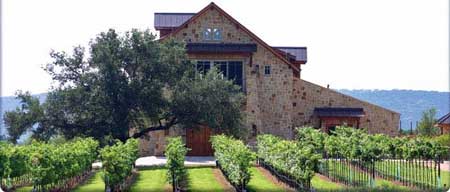
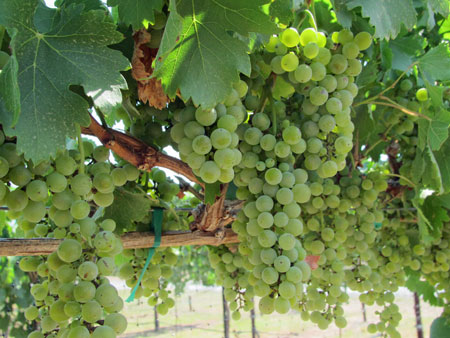
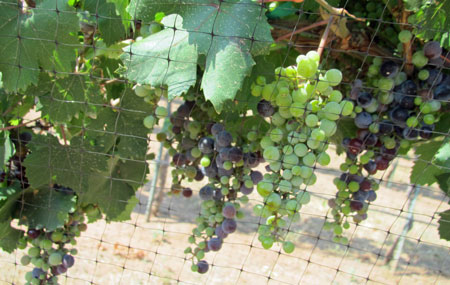
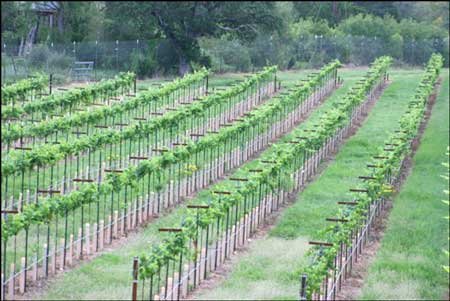
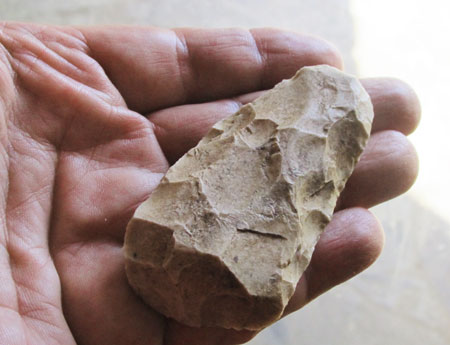
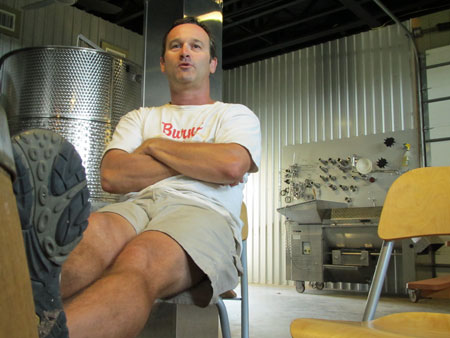
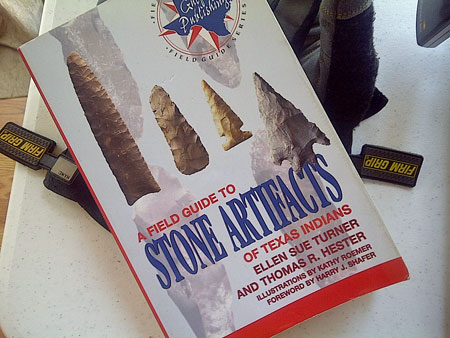

Great piece Russ. I really hope more people get exposed to what’s happening at Perissos. I have tremendous respect for the grapes Seth has decided to plant, he definitley falls into the category of “not your everyday grapes/wines, but they’re not from your everyday winery!”. Kudos to Seth and family for the quality of their all Texas grown wines, there are some very tasty offerings to be had. Seth has been inviting me to visit for years, maybe post harvest this year I’ll take him up on the offer! You both keep pushing the industry forward – cheers.
Bill @DuchmanWinery
Bill,
Seth was on my case to stop by last year. I’m glad he was. He finally catch me while I was at our hill country cottage and I made the short trip over to Burnet. Great estate vineyard and family run operation. Great wines too.
Hey luke, Get to diggin around the site where you found that point and discover the rest of it. Great article russ. I will get there one of these days. Come on by anytime Seth!